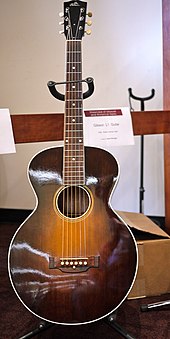Gibson L-1
| Gibson L-1 | |
|---|---|
 A Gibson L1 pictured at the 2012 Northwest Handmade Musical Instrument Exhibit. | |
| Manufacturer | Gibson |
| Period | 1902 - 1926, 1926 - 1937, 1991 - 1995, ? - present |
The Gibson L-1 is an acoustic guitar that was first sold by the Gibson Guitar Corporation in the early 20th century. The L-1 model was introduced first as an archtop (1902), and later as a flat top in 1926. The model is famously associated with the legendary bluesman Robert Johnson.
History
1902 L-1 introduction specs (acoustic archtop): single bound round soundhole with 2 rope pattern wood rings, single bound top, ebony fingerboard, dot fingerboard inlays, orange top finish, dark mahogany back and sides, 2 sizes.
1908 L-1 specs: 13.5" wide, narrower waist, trapeze tailpiece with pins anchored in tortoise celluloid plate, elavated pickguard, 13 frets clear of the body, bound fingerboard, slated "The Gibson" logo.
1912 L-1 specs: No pickguard.
1914 L-1 specs: Pickguard added again.
1918 L-1 specs: Sheraton brown finish. 1920 L-1 specs: Double 5 ply soundhole rings.
1925 Discontinued.
1926 Re-introduced as a flat top.
In the late 90s or early 2000s, Gibson introduced the L-1 Robert Johnson acoustic guitar model, the guitar features the historic small L-series body design (25" scale length), ebony bridge with carved pyramid wings, 3 3/4-inch soundhole diameter, and a Robert Johnson signature inlay at the end of the fingerboard.
See also
